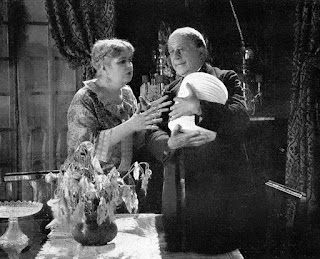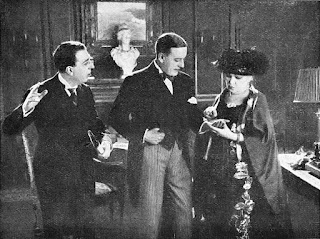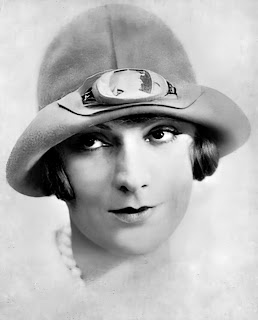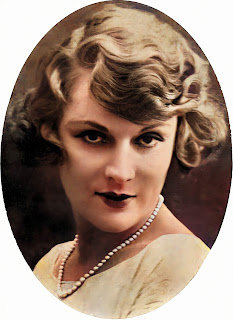A vaudeville for Vitagraph
Only here, not only the director has decided to stop his frolics, but in addition, the relatively advanced age of the lady makes it easy for him to resist her requests. Then comes Suzanne, who pretends to be Gilberte Lambertin and who does not leave the director unmoved. She saves her virtue by ringing the staff at critical moments and manages to land the coveted position for Lambertin.
Problem: once the latter is installed in his post, Mr. de La Mare visits him at the sub-prefecture and the misunderstandings that one imagines when presented to him the real Ms. Lambertin ensue. He thinks to confuse Suzanne by proposing marriage to her if she is indeed the one she claims. Naturally, Suzanne accepts and marries the director.
 |
| M. Bouquet crashes lunch at Ms. Mariolle's |
The Cast
This film has the particularity of bringing together several actors and actresses who will remain famous several decades later. First of all, Arlette Genny who under the name of Marie Glory will star for many great directors such as Julien Duvivier (S.S. Tenacity), Henri Fescourt (Monte-Cristo) and Roger Vadim (...And God Created Woman). It seems to be Pierre Larquey's only role on the screen of the 1920s but he will become one of the most popular supporting roles on the French screen, sometimes even with leading roles as in one of the first French color films, Eartth Dying.
 |
| Lucien Baroux, Jean Dax & Marthe Lepers |
Pierre de Ramey, here in the role of the nephew, will soon be exported to the United States to shoot films in French in Hollywood, notably alongside Maurice Chevalier.
However, the one that we find on the cover of the Cinémagazine newspaper on November 28, 1924 and May 8, 1925, and of Cinéa - Ciné Pour Tous on February 15, 1925 is Madeleine Martellet, who plays Gilberte and who will only be seen again a second and last time in a film with Huguette Duflos titled Yasmina.
 |
| Madeleine Martellet |
Finally, it is interesting to note that a small French "flapper" whose childish voice we will not yet be able to hear in this film, makes her first appearance. It is Christiane Virideau, who will later marry Jacques Tourneur, and will later live in Hollywood with him, and will land there the role of Snow White in the French version of the cartoon of Walt Disney.
Shooting and release
L'Intransigeant announces the filming that began on July 19, 1924, reports a large night scene in a huge swimming pool on July 26, and finally announces the filming ended on October 4. An end already announced since August 24 in Cinémagazine.
The press presentation took place on October 27, after which the newspaper published a positive review. As well as a quote from Saidreau: "The humorous side of a comic film must let emotion through; it is to the extent of this opposition that a good comedy is made."
Albert Bonneau describes in Cinémagazine of November 7, 1924 a new "very humorous" achievement and even gives us a photo. The film was released on January 23, 1925 at the Grand Cinéma Bosquet, the Palais Rochechouart and the Palais des Fêtes.
To read the next chapter on the work of director Robert Saidreau, click here.
Click "Like" on the Facebook page if you like my blog.
That's all for today folks! See you soon !
